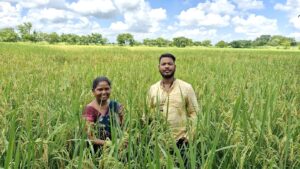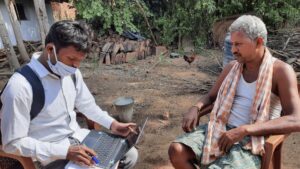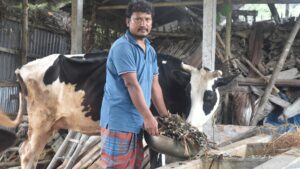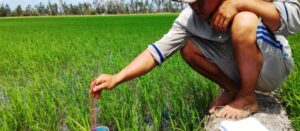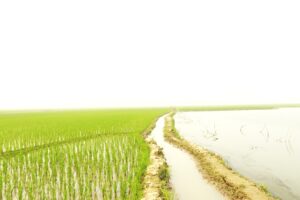by Justin McKinley, Jeffrey LaFrance, and Valerien Pede
Vietnam is especially vulnerable to the effect of climate change because of its geography and population demographics. Weather and climate, including rainfall and its timing, the day-to-day high and low temperatures, the frequency, length, and severity of droughts, and basic growing conditions are expected to become more variable for Vietnamese farmers in the near- and long-term future. This study provides policymakers with evidence of which stresses–and where–are already causing autonomous adaptations among individuals and the different responses individuals are using.
Vietnam is especially vulnerable to the effect of climate change because of its geography and population demographics. Vietnam’s vulnerability is high because of its large cities, coastal regions, and high mountain ranges. Additionally, low-lying river deltas add to its vulnerability and make it one of the most affected countries from adverse climatic stresses, such as flooding, saltwater intrusion, and drought.
Rural communities that rely on agriculture are some of the most vulnerable populations to climate change because they often have a vulnerable livelihood, reduced adaptive abilities, and live in high-risk areas. Seventy percent of Vietnam’s population lives in rural areas, and around 60% of the rural population relies on agriculture for their income.
The effects of climate change are felt disproportionately by poor households because their livelihoods are more dependent on agriculture than wealthier households, and climate change decreases agricultural productivity and food security. For example, rice production in Vietnam may see a yield reduction of as much as 23% and over 50% over the next two decades for irrigated and rainfed rice, respectively.
Increased climate variability will most threaten communities that rely on resources because of their increased vulnerabilities and risk exposure; this is especially true in rural development and agricultural sectors. Climatic stresses will be felt especially hard by agricultural households. There is evidence that these communities are already feeling these effects. A recent study found that farmers are losing 20% of their annual income from agriculture as a result of climate change.
Weather and climate, including rainfall and its timing, the day-to-day high and low temperatures, the frequency, length, and severity of droughts, and basic growing conditions are expected to become more variable for Vietnamese farmers in the near- and long-term future.
Studies have forecast increasing average temperatures, sea-level rise, changing precipitation, and increasing drought in regions of Vietnam, including the three regions covered in our study, the Red River Delta, Central Vietnam, and the Mekong River Delta. Some of these regional forecasts are the same, such as increasing temperature, frequency and intensity of storms, and drought. Other forecasts are variable over regions, Central Vietnam is forecast to have increased rainfall in addition to their seasonal drought, and the Mekong River Delta is forecast to be impacted by increased sea-level rise and salinity intrusion.
Sea-level rise of one meter is anticipated to cause severe impacts on the inhabitants of the Mekong River Delta, Red River Delta, and Ho Chi Minh City. In total, between 11 and 25% of the country’s population could be directly affected, and GDP losses are estimated to be between 10 and 25% with a one-meter and three-meter increase in sea level, respectively.
Declining agricultural production is anticipated in Vietnam because of direct effects (changes in carbon dioxide availability, precipitation, and temperatures) and indirect effects (reductions in water availability, the transformation of organic matter in the soil, increased pest and diseases prevalence, and loss of arable land resulting from the submergence of coastal lands and soil erosion).
With the presence of all these stresses, the Vietnamese government has been proactive in developing climate change policy. Vietnam, particularly the agricultural and rural development sectors, has developed comprehensive climate change policies with consideration given to adaptation and mitigation. Examples include the creation of the National Climate Change Strategy in 2011, which lays out strategic objectives to be accomplished by 2050, or the creation of the National Committee on Climate Change created in 2012.
However, there are opportunities for improvement by bringing in more local stakeholders. While the Ministry of Agriculture and Rural Development is ahead in developing policy frameworks for climate change adaptation, current systems do not adequately address the private sector and local community involvement in responses. Similarly, a key informant interview finds that policy still follows a top-down approach, with almost no consultation with local communities or organizations.
When working in this hierarchical governance system, any effort to support smallholders must be expanded to also engage in policy capacity to ensure efforts are successful. However, transformations in climate change adaption in Vietnam see local governments playing more important roles in climate change risk reduction—arguing that the role of local government is changing and becoming more responsive to facing climate risks.
Comprehensive policies with guiding rules to increase the participation of local communities and mechanisms to incentivize them to take part in climate change mitigation and adaptation are essential. Vietnam has several mitigation options available in agriculture, such as coffee intercropping, use of biochar in maize or rice, and the irrigation technique of alternate wetting and drying in rice production.
Still, climate change is already occurring regardless of how much mitigation is achieved, and moving toward climate change adaptation is urgent and necessary. Adaptation and mitigation are not alternatives and must both be pursued, but the costs will influence the choice of policies.
There are numerous climate change adaptations falling into different categories and at varying costs. A recent study finds that Vietnamese farmers’ adaptations are increasingly autonomous and less capital intensive. Autonomous adaptations are not conscious adaptations to climatic stimuli, but spontaneous responses triggered by changes in natural, market, or human systems.
Autonomous adaptations are widely considered to be reactive and undertaken by private actors instead of governments. Individuals only adopt private adaptations when they are efficient, i.e., when the benefits outweigh the costs, because all of the costs and benefits go to the individual who is making the decision. Autonomous responses are more often short-run adaptations because the impacts are less uncertain, and the benefits are more predictable. Long-run are less common than short-run adaptations because of the uncertainty and more substantial capital investments involved in long-term investments.
Individuals will make efficient adaptations if they have the resources to do so, but unexpected stress can lead to disruptions in livelihoods, resulting in increased vulnerability from reduced access to social, political, and economic resources. Microfinance has the potential to play a significant role in autonomous adaptations by providing households with access to necessary resources. Microfinance builds resiliency in households by making them less vulnerable to shocks from climatic stresses and more capable of coping with the impact.
This article set out to better understand if some climatic stresses or impacts from climatic stress elicited stronger climate change adaptations from individuals. The answer to this question is a resounding yes. At the individual adaptation level, drought, flooding, and to a lesser extent, storms and salinity intrusion, elicited the strongest autonomous adaptations from individuals.
The most common autonomous response at the household level is to have a financial adaptation, such as selling assets, borrowing money, or using savings. Households using a financial response may provide an opportunity for microfinance lending in Vietnam as a way to build capacity and reduce vulnerability in households as they adapt to climate change. Autonomous adaptations taken in the private market are generally understood to be efficient. Microfinance is a way for poorer households to access the additional resources necessary to carry out efficient autonomous responses to climate change.
Compared to the household level, sources of climatic stress are less critical for adaptation decisions at the agricultural level. At this level, impacts brought on by climatic stress elicited stronger adaptation responses from individuals than the sources of the stress.
Farmers who experienced low yields as a result of stress are more likely to adapt their rice-farming practices by changing the variety of rice that they grow. Our results provide field-level evidence that the sources of stress vary across landscapes in Vietnam. These results show the necessity for location-specific adaptation policies in Vietnam, which have been called for in previous publications.
Furthermore, this study provides policymakers with evidence of which stresses, and where, are already causing autonomous adaptations among individuals and the different responses individuals are using. Equally important as climate change action is climate change inaction.
We did not find climate change adaptations resulting from specific stresses, such as sea-level rise and saltwater intrusion. This leaves room for a government response to those stresses where private adaptations are presently absent. All the while, the government can financially support private autonomous adaptations, through channels such as microfinance lending.
Of course, autonomous adaptations alone are not enough. Instead, it should be seen as a way to help individuals help themselves in the short run, while other planned adaptations and mitigation options are established as part of a comprehensive climate change policy.
Read the study:
McKinley JD, LaFrance JT and Pede VO (2021) Climate Change Adaptation Strategies Vary With Climatic Stress: Evidence From Three Regions of Vietnam. Front. Sustain. Food Syst. 5:762650.

